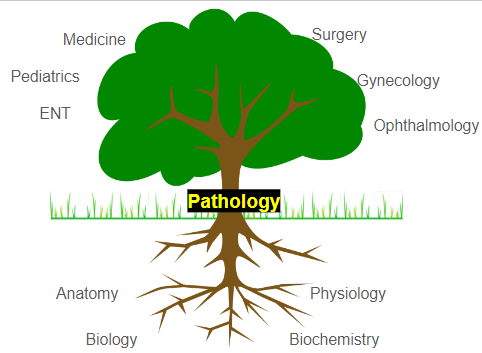Pathology deals with STUDY and DIAGNOSIS of disease. Pathology (trunk) connects the basic medical sciences (roots) to different clinical specialties (branches)

- Role in Diagnosis
- A pathologist helps the clinician to diagnose a disease by examining the patient’s blood or body fluids or any other tissue.
- Eg: Biopsy, Peripheral blood smear examination, Fine Needle Aspiration Cytology (FNAC), Peritoneal fluid examination etc.
- Role in Management of disease
- Assess effectiveness of treatment through different laboratory tests
- Eg:
- Effectiveness of therapy in iron deficiency anemia through Reticulocyte count (retic count will increase if therapy is effective).
- Peripheral blood smear examination for Blast cells (neoplastic cells) in treatment of Acute Leukemia (Blast cells will reduce in number during treatment)
- Role in study of disease
- Through research to find out cause, pathogenesis, diagnosis and effectiveness of treatment of disease.
- Eg:
- Use Immunohistochemistry in biopsy specimens to find out new therapeutic targets in a malignancy.
- Role in administration
- As a leader of various laboratory teams.
- Eg:
- Head of Cytopathology lab, histopathology lab etc.
- Main subspecialty labs in Pathology
- These are the most common labs which function under a Pathologist.
- Hematopathology
- Deals with study of cells in blood
- Eg: peripheral blood examination, bone marrow studies etc
- Cytopathology
- Deals with study of single cells which are found in body fluids or which are scraped or aspirated from areas of the body with suspected disease
- Eg: FNAC, Body fluid cytology
- Histopathology
- Deals with study of Tissue
- Eg: Biopsy
- Clinical Pathology
- Mainly deals with Body fluid cell count, differential count, Urine examination, Stool examination etc.
- Hematopathology
- These are the most common labs which function under a Pathologist.
Click the link for a POST TEST in google forms:
https://docs.google.com/forms/d/e/1FAIpQLSejkKNeaRVSeWupfskTmeIrSRPr9fY8Zag8Ug2j-AuIYQqxGw/viewform?usp=sf_link
